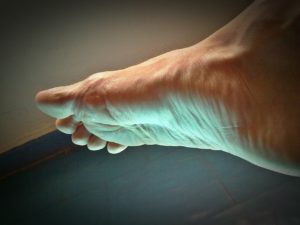If the bottom of your heel hurts and the pain doesn’t seem to be going away, you could be suffering from plantar fasciitis, one of the most common of all orthopedic complaints.
What is the plantar fascia? It’s a thin, web-like ligament that connects your heel to the front of your foot, supporting the arch of your foot and helping you walk. As you might imagine, these shock-absorbing, foot-supporting ligaments come under a lot of wear and tear – because you walk every day.
How does the pain feel? Some of our patients describe the pain as sharp and burning, while others say it is a dull ache on the bottom of their foot, extending toward their heel. When you take your first step in the morning or after you have been sitting for a long time, the pain is usually at its worst. Climbing stairs can be problematic as well because of heel stiffness. The pain can also be felt just after stopping an activity.
What causes the pain? If too much pressure is placed on your feet, the plantar facia ligaments may become damaged or torn. They become inflamed, causing heel stiffness and pain. Most commonly, this pain is experienced in the bottom of the heel, although it is sometimes experienced along the bottom of the foot. The pain can develop over time, and you may not realize what’s happening. It usually affects just one foot but can affect both. Tight achilles tendons (which attach your calf muscles to your heels) can cause this pain, and shoes with poor arch support or soft soles can also be sneaky culprits.
Who is at risk? If you are overweight or obese, you are at a greater risk of developing plantar fasciitis – because of the increased pressure on your ligaments. Women who experience a sudden weight gain in pregnancy often experience plantar fasciitis. Runners, factory workers or restaurant servers are also at greater risk. It is more common in women than in men.
If you are experiencing what you believe to be plantar fasciitis, give us a call. Physical therapy can be an important part of treating it. We can show you exercises to strengthen your lower leg muscles – to help stabilize your walk and lessen the pressure on your plantar fascia.















